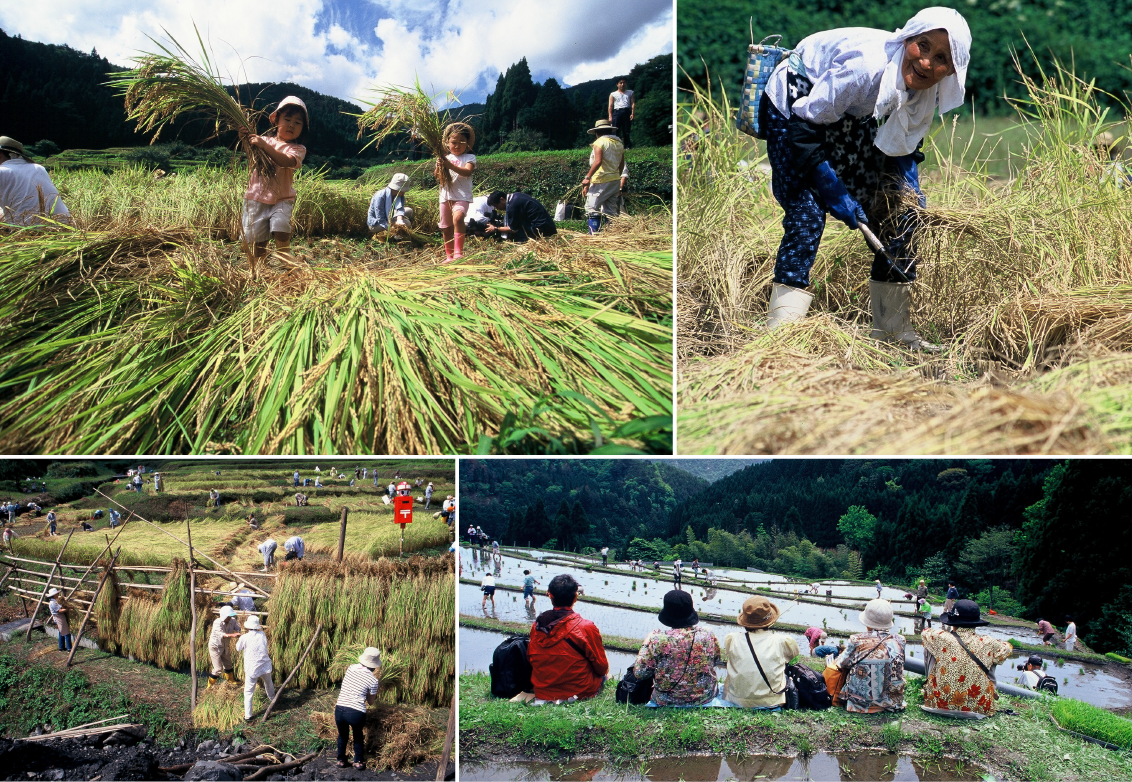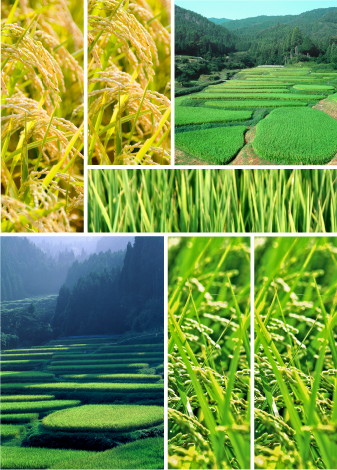
萩乃露は2002年から棚田保全を目的に「里山」というお酒造りに取り組んでいます。「里山」は滋賀県で唯一「日本の棚田百選」に選ばれた地元高島町にある「畑(はた)の棚田」で収穫された「こしひかり」で純米吟醸酒を造り、日本酒を通じて棚田の現状、棚田保全の必要性を伝えています。

Saving Our Endangered Rice TerracesBeautiful rice terraces are a common sight in the area around our brewery. These date back to olden times, when—with steep slopes where Lake Biwa meets the mountains—our forefathers had to cut open the land itself in order to farm rice.
These rice terraces are among the most idyllic and timeless scenes of the Japanese landscape. In spring, the surface of the water that fills the paddies reflects the blue sky and the verdure of the mountains. In summer, the young stalks sway in the wind. In the fall, the fully-grown stalks glisten in gold, and in the winter, the terraces turn white with the veil of snow.
Of the rice terraces around our brewery, the largest and most beautiful of all is the Hata rice terraces, recognized as one of the most impressive rice terraces in all Japan. Three hundred and fifty-nine rice paddies cover a total of 38 acres (15.4 ha) in all sort of geometric shapes and patterns. Spanning a hundred meters from top to bottom, the terraces form a bowl shape that it is said to have reached nearly to the top of the mountains in times of old, filling the eye with the grandeur of gold come harvest season. These days, sadly, these beautiful rice terraces find themselves struggling for survival. Farming is difficult, output is small, and damage from wild animals is a constant danger. Each year, more and more paddies are abandoned. As these rice terraces are an important part of the ecosystem, and also serve as natural dams, their loss presents numerous dangers for the environment.
Since 2002, we at Hagi-no-tsuyu, have been brewing a premium sake, Satoyama Junmai-ginjo, with Koshihikari rice harvested from the Hata rice terraces. Through our sake, we seek to protect this natural treasure from abandonment and extinction, and share its marvels with the modern world.
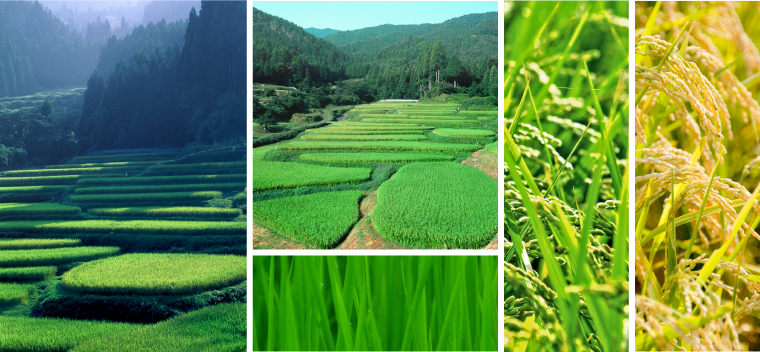

-
純米吟醸 里山 無濾過生原酒
カテゴリ:数量限定販売
(4月蔵出し)
原料米:こしひかり
精米歩合:60%
呑み方:
冷酒◎ 常温○ 燗酒△- 容量/価格:
- 1800ml / ¥3,300(税込¥3,630)
720ml / ¥1,800(税込¥1,980)
-
純米吟醸 里山(火入)
カテゴリ:通年販売
原料米:こしひかり
精米歩合:60%
呑み方:
冷酒◎ 常温○ 燗酒△- 容量/価格:
- 720ml / ¥1,700(税込¥1,870)

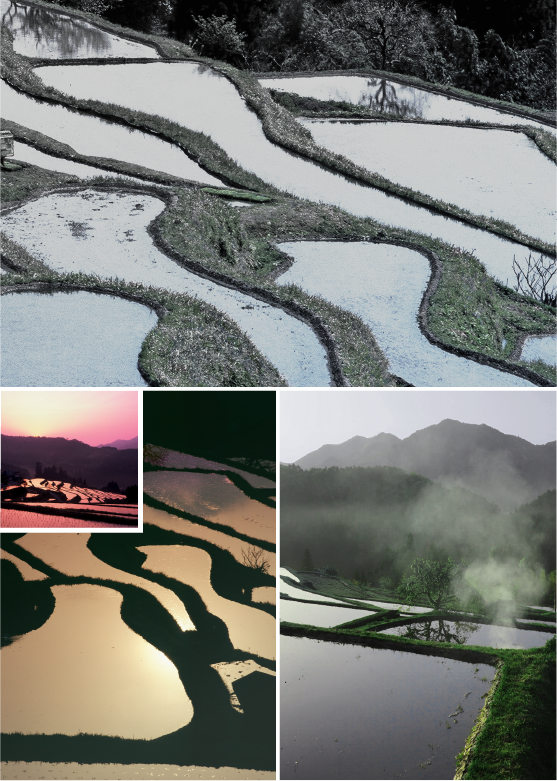
琵琶湖の西岸地域、特に萩乃露の地元高島市高島町周辺では棚田を目にすることがよくあります。これは琵琶湖と山が近接しているために平地が少なく、昔の人たちは稲を栽培するために山を切り開き、田んぼを作り棚田が形作られたからです。 棚田の広がる風景は日本の原風景といわれる美しさがあります。四季折々に変化し、春には田んぼの水面に空の青や山の緑が映る風景、夏には瑞々しい若稲が風にそよぎ田んぼを緑に彩る風景、秋にはたわわに実った稲穂が黄金色に輝く風景を見せてくれます。
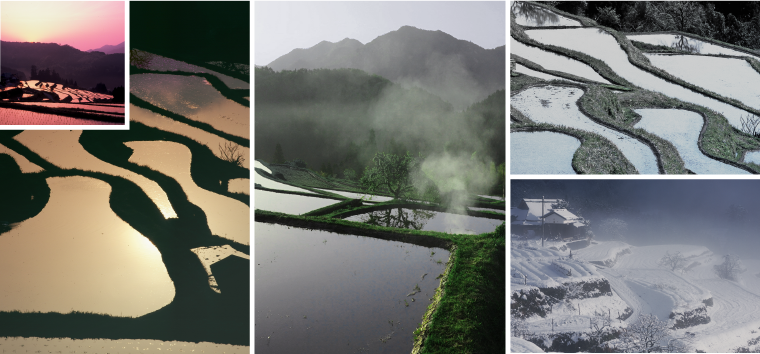
当地を代表する「畑の棚田」には359枚、15.4haの棚田が幾何学模様に広がります。標高差は100mに及び山腹にすり鉢状に広がる棚田はその昔は山頂付近まで連なり、実りの秋には静かな山里を黄金色に変えたと言われる雄大なものです。
「畑の棚田」にはその美しい景観に惹かれてたくさんの方が訪れる一方で、山間地にある棚田特有の作業環境の厳しさ、山に近接しているために起こる野生の生き物による農作物の被害、低い栽培効率などが災いし休耕田が年々増え、存続の危機に瀕しています。また、棚田は豊かな生態系の維持に大きな役割を果たし、ダムとしての機能を果たすなどの役割を持っており、棚田の荒廃が進むことで様々な問題が起こることが予想されます。


一般的に日本酒を作る際、酒造り専用の米「酒造好適米」を使用します。「酒造好適米」は旨みが少なく、歯ごたえもありませんので食べてもあまり美味しくありませんが、日本酒に用いると上品で程よい味わいを表現できるたいへん酒造りに適した品種です。もちろん私たちが普段美味しく食べている「こしひかり」などの飯米でも日本酒は造れますが、あまり美味しいお酒にならないことは酒造関係者の間ではよく知られています。
その為、何故「里山」は「こしひかり」で造られているのか、何故「山田錦」などの酒造好適米で造らないのかと聞かれます。実は当初は「畑の棚田」での酒造好適米栽培を検討しました。酒造好適米は一般的に飯米に比べ約一ヶ月収穫が遅い晩生品種が多いのですが、「畑の棚田」では「こしひかり」しか栽培されていませんでしたので、酒造好適米を栽培した場合、「こしひかり」が収穫された後の一ヶ月間、酒造好適米の田んぼだけが取り残される形になります。棚田は山を切り開いて作ったものですから、当然棚田は山に囲まれ、山には多くの野生動物がいます。取り残された酒造好適米は猿、鹿、猪の格好の餌食となり、収穫される望みがない事は容易に想像できます。酒造好適米の栽培にこだわっていては棚田保全のためにならないのです。そして「畑の棚田」で従来から栽培されている「こしひかり」での酒造りへの取り組みが始まります。

Sake is typically brewed from special breeds of rice collectively known as sake rice. These rice breeds have less flavor and texture than other rice breeds when eaten, but are perfectly suited to brewing sake, where they produce an elegant and balanced flavor. Just as sake rice can be cooked and eaten, regular rice breeds such as the popular Koshihikari can be used to make sake, but it is common knowledge among brewers that such sake is often not particularly tasty. So why are we at Hagi-no-tsuyu committed to brewing our Satoyama sake with Koshihikari rice, as opposed to Yamadanishiki or one of the many other breeds of sake rice? As a matter of fact, we first explored the possibility of growing sake rice in the Hata rice terraces. Unfortunately, sake rice breeds typically mature nearly one month later than Koshihikari, the only breed grown at the terraces. Were we to plant sake rice in the fields, the mature stalks would remain after all the other rice had been harvested, making the fields a prime target for the wild monkeys, deer, and boar that make their home in the neighboring mountains. It soon became clear that safely harvesting this rice was a hopeless proposition, and that clinging stubbornly to the idea of growing sake rice would not contribute to our goal of saving the rice terraces. So it is that we resolved to brew sake with the Koshihikari rice produced at the Hata rice terraces.



「こしひかり」での酒造りは予想通りに難しいものでした。もちろん日本酒にはなりますが、やはり中々満足の行く味わいにならないのです。棚田保全のためにがんばっているから応援してやろうということで、我慢して飲んでいただいたお客様も多く、ご迷惑をおかけしたと思います。しかし経験を重ねるごとに品質も向上し、3年目には「里山」は美味しく飲んでいただけるレベルに達することができました。その後年々改良を加え、酒造関係の方に飲んでいただくと「どうしたら「こしひかり」でこんなに美味しい日本酒が造れるのか」と質問を受けるまでの品質となりました。ある年にお客様から「銘酒「里山」に出会えて良かった」という葉書もいただきました。そんなお客様に支えられて十数年間取り組みを続けることができました。現在の「里山」の品質は十数年にわたり繰り返した試行錯誤の成果でもありますが、「畑の棚田」では山の美しい清水が豊富にあり、昼夜の寒暖の差が大きいなど米作りの条件に恵まれ、すばらしい品質の「こしひかり」が栽培されていることが大前提となります。どこの「こしひかり」であっても美味しいお酒を造れるわけではないのです。

Sure enough, brewing sake from Koshihikari rice proved to be a considerable challenge. Of course, we were able to brew sake, but achieving a taste that could meet our standards was another story. We feel deeply apologetic toward the customers who drank our first few batches of Satoyama to support our environmental conservation efforts, in spite of its taste.
Fortunately, experience allowed us to improve the next year, and the next, and in the third year of brewing, we finally achieved a sake whose taste truly stood on its own merits. We have continued to explore ways to finetune our brewing process, to the point that today, other brewers often come to us to ask just how we are able to brew such a delicious sake using Koshihikari rice.
One year, a customer paid us the highest compliment when he told us “I feel truly blessed to have discovered the most miraculous sake, Satoyama.” It is such words from our customers that have supported us for the ten-plus years that we have been brewing Satoyama.
The Satoyama that we brew today is the fruit of over ten years of experimentation and effort here at Hagi-no-tsuyu, but more than that, it is the product of the Hata rice terraces—with their pristine waters that run down the mountains, the sharp temperature difference between night and day, and all the natural blessings that contribute to the remarkable Koshihikari rice produced here. We know that we could not make this delicious sake with Koshihikari grown just anywhere.

高島市では棚田オーナー制度を実施しています。棚田オーナー制度で田植えや稲刈りなどを行いますと、集落の人口を大幅に超える数の棚田オーナーさんがお越しになり、一緒に作業を楽しみます。棚田オーナー制度の中に「酒オーナー制度」があり、畦塗りから田植え、草刈、収穫などの農業体験、そして農業体験の合間には「畑の棚田」で採れた「こしひかり」で握ったおにぎりを楽しみ、冬には弊社の蔵見学と収穫米で造った「里山」をお渡しするという内容で実施しており、何年にもわたって三世代で参加いただいている家族、お酒が好きで参加いただいているグループ、遠くは愛知県からお越しになるご夫婦などがいらっしゃいます。棚田オーナー制度で多くの方が棚田の現状を理解し、ご協力いただいているとはいえ、棚田保全は簡単なものではありません。押し寄せる高齢化と人口減少の波は棚田にも大きな影響があります。未来にわたる棚田保全の道筋はいまだ見えていませんが、今後も「里山」を通じて棚田保全に取り組んで行きたいと思いますので、応援のほどよろしくお願い申し上げます。

In the city of Takashima where our brewery is located, an Adopt-a-Terrace program allows people to experience having a rice terrace of very their own. Every year, people come in numbers vastly exceeding the population of the small village where the terraces lie to plant and harvest rice together with local famers. Among these programs, there is a special course for sake lovers. Members can experience drawing furrows, planting and harvesting rice, then visit our brewery in the winter and receive for themselves Satoyama sake brewed with the rice they planted and harvested. Our participants include families that come year after year in three generations, groups of friends united by a love of sake, and a husband and wife who travel in all the way from Nagoya. While we are proud that this program has contributed to a greater understanding of the issues facing the rice terraces, we know that the conservation effort is no small task. Population decline and the aging of Japanese society also threaten the livelihood of the terraces. We understand that our humble efforts are but one piece of the puzzle, but your support of Satoyama and our mission to preserve the marvel of man and nature that is the rice terraces is deeply appreciated.
